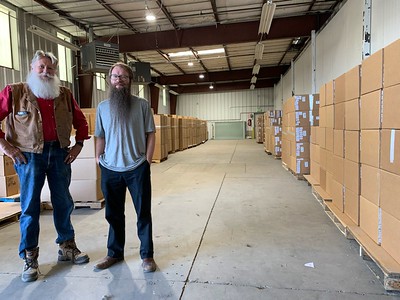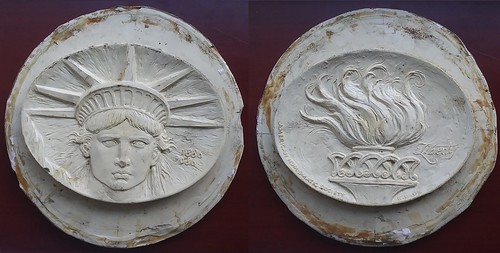
PREV ARTICLE
NEXT ARTICLE
FULL ISSUE
PREV FULL ISSUE
MOVING MEDALLIC ART COMPANY ARCHIVES, PART 2Dr. Jesse Kraft of the American Numismatic Society published an ANS Pocket Change blog article, the second segment of a three-part series about the laborious move of the Medallic Art Company archives, purchased by the Society in 2018. Here's an excerpt, but be sure to see the complete article online -Editor On May 22, with laptop, overly-detailed excel spreadsheet, and solid strategy in mind, I boarded a plane destined for Reno, Nevada. My fine Hyundai Santa Fe rental then took me half-an-hour south to Carson City (just 6.5 miles east of Mound House), to the hotel I would call home for the next 13 nights.
That first evening, I had the pleasure of meeting Rob Vugteveen, self-proclaimed Figure 1. Jesse Kraft (r.) and Rob Vugteveen (l.) in Mound House, NV, beginning to prepare the MACO die shells for their journey across the country.
Pallet-by-pallet, we compared them to the MACO Spreadsheet and used red and green Sharpies to mark the individual item labels with their respective color. From there, we were essentially able to ditch the spreadsheet and work directly from the boxes. We now began on an item-by-item level—opening each box and separating the We had gone through 12 pallets (192 boxes) before suddenly realizing that, at this rate, we would run out of time without even starting on our second task. One achievement from the process, however, was that by the time we were through those 192 boxes, there were only 182 boxes left on the pallets, as we were able to condense those initial boxes by about 5%. Even greater efficiency was found in the fact that we were able to stack the boxes 5-high (as opposed to 4-high, as they previously were) due to information garnered from the shipping companies. This simple change saved an astounding 25% of space. The next day’s focus was on task number two: repacking what truly needed to be repacked. Due to time constraints in 2018, only about 15,000 of 20,000-odd die shells were photographed, individually wrapped, and safely packed into boxes. At that time, the crew was unable to complete the final 5,000 objects of the collection, so (out of necessity) they were hastily stacked into boxes directly on the pallet. Packed for a quick 6-mile jaunt from Dayton to Mound House, they would not likely survive the 2,500-mile journey they are about to make. Sadly, even now, we found pieces that were clearly broken in their prior transit, not before. Figure 5. Epoxy die shells for the 1986 ANS medal to commemorate the centennial of the Statue of Liberty. Most of these objects are epoxy die shells (Figs. 5 & 6). Epoxy die shells were introduced in 1975 as a cheaper and quicker alternative to copper galvano die shells. Unlike the hardy copper die shells made by MACO, the epoxy die shells are quite fragile and if one were dropped on the floor, it could easily shatter on impact. Not only were these most-fragile die shells in direct contact with each other, but each box weighed far beyond their intended capacity. I am happy to report that Rob Vugteveen and I achieved 95% of what we had hoped to before the time came for me to leave. Thankfully, Rob lives nearby and is able to wrap everything up before the trucks arrive. All in all, the second phase of getting the MACO die shells from Mound House to Manhattan was a success.
To read the complete article, see:
To read the earlier E-Sylum article, see:
Wayne Homren, Editor The Numismatic Bibliomania Society is a non-profit organization promoting numismatic literature. See our web site at coinbooks.org. To submit items for publication in The E-Sylum, write to the Editor at this address: whomren@gmail.com To subscribe go to: https://my.binhost.com/lists/listinfo/esylum All Rights Reserved. NBS Home Page Contact the NBS webmaster 
|


